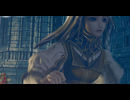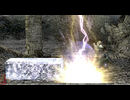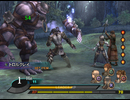|
|

|
BATTLE SYSTEM
|

|
INTERACTION
|

|
ORIGINALITY
|

|
STORY
|

|
MUSIC & SOUND
|

|
VISUALS
|

|
CHALLENGE
|
Medium
|
COMPLETION TIME
|
40+ Hours
|
|
OVERALL
4.0/5
|
Rating definitions
|
|
|
For treason against Asgard, Odin the All-Father has banished Silmeria, one of his Valkyries, to Midgard to live as a human; however, something went wrong during her transmutation, and she finds herself in the body of Alicia, Princess of Dipan. Alicia soon finds herself pursued by Hrist, another of Odin's Valkyries, and, with Silmeria's guidance, flees her castle, seeking protection of Dipan from the wrath of the gods while obeying the rogue Valkyrie's wishes for vengeance upon Asgard. Valkyrie Profile 2: Silmeria takes place several centuries before its predecessor, Valkyrie Profile: Lenneth, and proves to be a solid sequel for those willing to accept the changes made.
As in Lenneth, though, exploration still occurs in two-dimensional towns and dungeons with many platforms and obstacles, with enemies, of course, wandering the latter. By the way, the Period system from Lenneth is absent, so players aren't under a time crunch this time around. Anyway, Alicia, with Silmeria's powers, can fire photons at enemies to freeze them temporarily, and even fire at frozen enemies to exchange places with them; players can also use frozen enemies as platforms to reach higher places, with mastery of crystal-exchange sometimes being necessary to reach places and treasure out of reach. Alicia, too, can slash enemies to begin a fight, though if she contacts a foe without slashing, enemies will sometimes take her party by surprise.
Instead of taking place on a static field like in Lenneth, combat in Silmeria occurs on a vast three-dimensional field, with numerous tactical elements in combat. Players can move their party of up to four characters around the field and its various obstacles near enemies, and begin an attack when near them. Each active character is assigned to one of the face buttons like in Lenneth, and when the player begins pressing them, combat shifts to a side-view akin to Lenneth where characters attack the enemy, with a special attack gauge filling up with each hit and an AP gauge gradually draining as the party attacks.
 Run, Alicia, run!
Run, Alicia, run!
|
|
The AP gauge is refilled through various means, such as entering an enemy's red attack zone and enduring its attack, simply moving around the field, or holding down the left analog stick, in which case enemies will simultaneously move around the field (as they also do when your party moves around), as AP recharges. Players can also consume AP to have the party dash across the field and beyond enemy attack zones, which can be useful in approaching a leader enemy that usually accompanies every normal battle, whose defeat spells the end of the battle. Taking out leader enemies usually makes combat go quicker, and is even encouraged since a bonus gauge multiplying experience gradually depletes as a fight drags on.
If the special attack gauge fills up to a hundred points during player attacks, any character that participated in the attack, if their current weapon allows, can perform a powerful Soul Crush attack to deal further damage and again attempt to fill the special attack gauge to a hundred points; if so, the player can perform yet another Soul Crush attack until all characters have used theirs once. Players can also assign up to three normal attacks to their characters outside of battle depending upon their weapons, with each normal attack filling up the special attack gauge by a certain amount, having a certain number of hits, and consuming a certain amount of AP.
Players can also access the combat menu to have a character use an item or spell, after which the battle menu is disabled for a certain amount of time. Another interesting feature, moreover, is the ability of your characters at times to break off certain appendages of enemies, in which case they have a chance of getting a special item. Sometimes when attacking, your party might enter Break Mode, where they can freely attack an enemy without using AP while having a chance to break off more enemy parts and far more easily kill the foe.
 Better chance of this than winning the lottery...
Better chance of this than winning the lottery...
|
|
Combat also has many key elements outside of battle. Each character can equip up to eight pieces of equipment, with many pieces of equipment having a particular rune assigned to them. When players combine certain runes, they can form innate skills that the character will gradually learn through fighting battles, and ultimately master, after which the player can equip these skills, which require a certain number of Capacity Points, with each character, of course, having a maximum amount of CP.
As for those items occasionally gained by breaking off enemy appendages, players can sell them at shops in order to make and buy more powerful equipment for their characters, although odds are that they'll spend far more time hunting for required items than actually using the equipment they can ultimately buy, yet thankfully, doing so is hardly necessary to complete the game successfully.
Occasionally in dungeons, furthermore, players might stumble upon weapons that can be materialized into Einherjar, who can fight normally in battle alongside story characters. After players increase their levels by five, they can free their souls and gain various stat-increasing items. Since Alicia and Rufus are the only characters that stay with you the entire game, I should mention, it's a good idea to use these items only on them, given that nearly all other story characters will ultimately leave your party permanently. You can also occasionally find resurrected Einherjar in towns and dungeons, and talking to them can sometimes earn you items and money.
Yet another aspect affecting combat are Sealstones, which have various effects on your party and dungeon chambers, and require a certain amount of gems (gained through combat) to "restore," in which case players can use those Sealstones in other dungeons. Players can remove Sealstones from special springs in dungeons and switch them out at special pedestals. Sealstones have various effects such as increased money from battle and increased party stats.
 "Don't heal the enemy, you moron!"
"Don't heal the enemy, you moron!"
|
|
Although the battle system, as you can probably tell by the lengthy description, is fairly complex, it's actually quite easy to get a handle of and ultimately master, with the fact that you don't have to kill every enemy in battle making combat far quicker, and allowing for easier leveling if necessary, and weapons, thankfully, don't break often like in Lenneth (although there is a Sealstone that can allow for weapon breakage alongside increased attack power).
The game itself, for the most part, isn't terribly difficult, although some bosses can pose a challenge, (though the final boss, in my opinion, is really more of a powerful wall trying to prevent you from seeing the ending). There are some minor flaws, as well, such as the tendency of your characters at times to get stuck against obstacles on the field, as well as the tedium of breaking your party into two teams and managing both (which is actually useful against some tough bosses, though). Otherwise, combat is one of the main draws to Silmeria as long as you enjoyed Lenneth yet didn't consider it to be flawless.
Interaction could've used a bit more work, though. With the mentioned rune system, for one, managing your characters' equipment can be burdensome, especially since the interface doesn't show you right away which other gear a character can equip to form a skill, and an "equip best" option might've been nice, as well; that your party can grow large at times can also increase the tedium of character management, although resurrecting Einherjar can reduce your party size. Shopping can be a bit troublesome, as well, although finding out how to advance the game is no problem, and dungeons have handy automaps. Overall, interaction could've been better, yet doesn't severely detract from the game.
Despite being a sequel, Silmeria remains surprisingly fresh, introducing some innovative elements such as the heavy tactical aspect of combat, leader enemies, breaking off enemy parts, Sealstones, and so forth. There are some elements retained from Lenneth, though, such as 2-D dungeons, the side view of your characters attacking enemies, photon-firing, certain characters, and so forth, but otherwise, Silmeria is definitely a unique experience.
 Alicia hunts for insurgents
Alicia hunts for insurgents
|
|
The story, though, does suffer from some deep flaws, chiefly with pacing, which can be very poor at times and can often make the plot seem disjointed. Still, there's actual character interaction unlike in Lenneth, where your allies were basically forgotten once you got them in your party. Unfortunately, the Einherjar really don't affect the main storyline, although they do have some backstory you can read in the game menus (the main story characters have descriptions in the menus as well). However, some fans will be happy to see links to Lenneth, though some create a few holes and potential inconsistencies, and players learn little about why Silmeria was banished from Asgard in the first place. All in all, the story definitely walks the line between being interesting, confusing, and sluggishly-paced.
The soundtrack, too, is a bit of a letdown, with standard tri-Ace composer Motoi Sakuraba returning. There are some decent orchestrated tracks, although most of the music is fairly subdued compared to his previous work, and lacks the energy of his soundtrack for Lenneth as well as a central theme and several remixes of it. The voicework is tolerable, yet isn't perfect, with Rufus, for instance, showing about as much emotion as an old cat, alongside terrible lip-synching which, surprisingly, also plagued the Japanese version. Overall, the music certainly won't drive you to buy the soundtrack, and the voicework definitely won't win any awards.
The world of Silmeria, though, is a grand sight to behold, with the visuals perhaps being among the most realistic ever to appear on the Playstation 2, with superb character models and nice scenery, alongside excellent FMVs. The graphics do show some technical flaws, however, such as fuzziness during many cutscenes, occasional choppiness in battle, and so forth, but are otherwise one of the main draws to the game and among the best on the Playstation 2.
Silmeria, finally, can prove to be a lengthy game, at least forty hours long if players breeze through, although sidequests, leveling, and a challenging extra dungeon, the Seraphic Gate, can significantly bolster playing time. After beating the game, moreover, players can start a new game with a higher difficulty level.
Overall, Valkyrie Profile 2: Silmeria, is a solid sequel that successfully builds upon its predecessor's mechanisms, with solid combat and decent presentation in spite of some shortcomings here and there. Admittedly, if you think Lenneth is one of the greatest RPGs ever made and that altering its mechanisms is heresy, it might disappoint you, although if you're an RPGamer who easily adapts to change in any series, you'll likely have a good time if you can master it.
Review Archives
|









